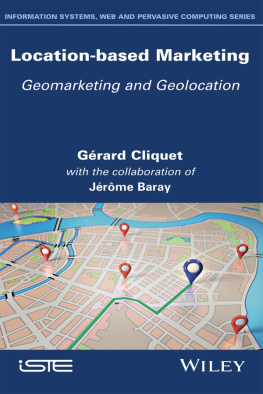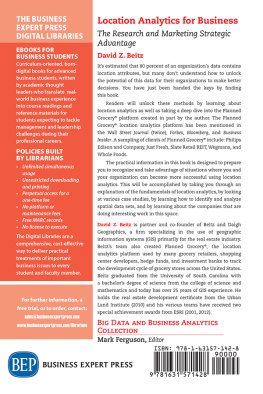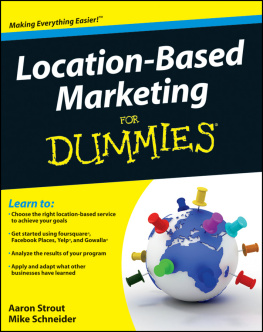Gérard Cliquet - Location-Based Marketing
Here you can read online Gérard Cliquet - Location-Based Marketing full text of the book (entire story) in english for free. Download pdf and epub, get meaning, cover and reviews about this ebook. year: 2020, publisher: Wiley-ISTE, genre: Romance novel. Description of the work, (preface) as well as reviews are available. Best literature library LitArk.com created for fans of good reading and offers a wide selection of genres:
Romance novel
Science fiction
Adventure
Detective
Science
History
Home and family
Prose
Art
Politics
Computer
Non-fiction
Religion
Business
Children
Humor
Choose a favorite category and find really read worthwhile books. Enjoy immersion in the world of imagination, feel the emotions of the characters or learn something new for yourself, make an fascinating discovery.
- Book:Location-Based Marketing
- Author:
- Publisher:Wiley-ISTE
- Genre:
- Year:2020
- Rating:4 / 5
- Favourites:Add to favourites
- Your mark:
- 80
- 1
- 2
- 3
- 4
- 5
Location-Based Marketing: summary, description and annotation
We offer to read an annotation, description, summary or preface (depends on what the author of the book "Location-Based Marketing" wrote himself). If you haven't found the necessary information about the book — write in the comments, we will try to find it.
Location-Based Marketing — read online for free the complete book (whole text) full work
Below is the text of the book, divided by pages. System saving the place of the last page read, allows you to conveniently read the book "Location-Based Marketing" online for free, without having to search again every time where you left off. Put a bookmark, and you can go to the page where you finished reading at any time.
Font size:
Interval:
Bookmark:

Grard Cliquet
with the collaboration of
Jrme Baray

First published 2020 in Great Britain and the United States by ISTE Ltd and John Wiley & Sons, Inc.
Apart from any fair dealing for the purposes of research or private study, or criticism or review, as permitted under the Copyright, Designs and Patents Act 1988, this publication may only be reproduced, stored or transmitted, in any form or by any means, with the prior permission in writing of the publishers, or in the case of reprographic reproduction in accordance with the terms and licenses issued by the CLA. Enquiries concerning reproduction outside these terms should be sent to the publishers at the undermentioned address:
ISTE Ltd
27-37 St Georges Road
London SW19 4EU
UK
www.iste.co.uk
John Wiley & Sons, Inc.
111 River Street
Hoboken, NJ 07030
USA
www.wiley.com
ISTE Ltd 2020
The rights of Grard Cliquet and Jrme Baray to be identified as the authors of this work have been asserted by them in accordance with the Copyright, Designs and Patents Act 1988.
Library of Congress Control Number: 2019957599
British Library Cataloguing-in-Publication Data
A CIP record for this book is available from the British Library
ISBN 978-1-78630-580-0
This book is a follow-up to the book Geomarketing: Methods and Strategies in Spatial Marketing published by the publisher ISTE (London) in 2006, then translated into Chinese in 2012 (translation by Pan Yu and Gao Li) under the title  .
.
This new opus is no longer a collective work, but the work of a single author who has tried to bring together the main concepts, methods and strategies to implement marketing that takes space into account.
It therefore not only emphasizes the importance of mapping in marketing decision making, but also seeks to highlight the importance of a more spatialized vision of these marketing decisions in order to better reflect the realities of markets, whether local or international.
The technological progress made and more particularly the arrival of mobile tools from information and communication technology (ICT), especially tablets and smartphones, have led the author to take an interest in the specificities of geolocation, to use this pleonastic expression. For a long time, location was reserved for buildings with an economic purpose, such as factories (Weber 1909; Merenne-Schoumaker 2002) or shops (Huff 1964; Applebaum 1966). Now, it is individuals and, with regard to marketing, consumers who can be geolocated and whom it is possible to address directly via email, SMS or even social media, which makes it possible to boost marketing strategies. ICT is disrupting the daily lives of consumers and practitioners, whether retailers or industrialists. Many companies have not yet taken advantage of the opportunities offered by these technologies, and when they have acknowledged them, they are still looking for ways to use them to improve contact with their customers. These developments do not take place without raising legal issues of privacy concerns, which will also be mentioned, as the academic community has been addressing these risks very early on.
This book offers a synthesis of knowledge concerning consumer behavior, the elements of the marketing mix with of course store location in a specific section, and therefore these new aspects related to geolocation that the integration of geolocation systems in new ICT tools allows.
The author sincerely thanks Jrme Baray, Professor at the University of New Caledonia in Nouma, Dany Vyt, Associate Professor at the IGR-IAE and Pierre-Alain Guillo, Associate Professor at the Faculty of Economics, both at the University of Rennes, for their comments. He is also very grateful to the company Articque for the supply of maps that will found in this book, as well as to Mr. Philippe Latour for the supply of an illustration from his company Spatialist.
Grard CLIQUET
January 2020
This book attempts to take stock of knowledge and applications in an evolving field. It focuses on aspects related to the discipline of marketing, while others provide a broader vision of digital geography applications, using computer science, in management sciences (Caron 2017). Digital geography has also been implemented in many fields such as weather, military strategy and environmental crisis monitoring (Plantin 2014).
Research based on spatial considerations began in economics as early as the 19th Century (von Thnen 1826; Weber 1909). Publications published around the 1930s would leave their mark on the economy (Hotelling 1929) and marketing (Reilly 1931) for a long time, alongside the work of geographers of the time (Christaller 1933; Lsch 1941). But the importance of the geography of marketing began to be recognized in the 1960s (Revzan 1968). This evolution also marks the birth of retailing (Scott 1970), that is, the activity of selling goods in stores or on the Internet of this book will be entirely devoted to georetailing.
The interest of multidisciplinary research, particularly of course with geography, lies in the possibility of bringing out the determinants and models of store location by linking business units and geographical elements and highlighting their evolution. This takes into account population disparities within regions, changes in the urban economy with spatial interactions within market areas and trading areas, while taking into account competition, commodity flows and geographical barriers. But only store location specialists, retailers, will continue in this direction, with traditional marketing remaining largely aspatial. However, will show that all marketing can be impacted by the need to spatialize studies, especially since recent technological advances in mapping.
English speakers do not normally use the word geomarketing, instead making a distinction between GIS (geographic information systems), geodemographics, which is the study of people according to their place of residence (Johnson 1997; Gonzlez-Benito et al. 2007), and micromarketing, which is defined as the customization of marketing mix variables at the store level (Montgomery 1997; Swinyard 1997). Finding English language sources for geomarketing is therefore not always easy. This book will help the reader in this respect by providing him or her with a large number of bibliographical references.
In terms of geomarketing considered as a set of techniques to map many social phenomena, as we will see, we could also go back in time and recall the role of the Belgian Grard de Kreme, known as Grardus Mercator, who invented mapping in the 16th Century (Horst 2011). In the 18th Century, the first map of the Kingdom of France was drawn by the Cassini family and this work, based on geodesic triangulation, lasted more than 60 years. Today, we still consult Cassinis map for historical works. And, older readers will surely remember the geography courses and maps of Vidal de la Blache (often called Vidal-Lablache).
But while geomarketing is a set of mapping techniques, spatial marketing is above all a much broader field, not only in methodological terms, but also and above all in conceptual and theoretical terms, which should enable private or public organizations to define more precise and appropriate strategies: space is not only geographical, it is also economic, cultural and institutional if we break down the notion of distance according to the Uppsala model (Johanson and Wiedersheim-Paul 1975).
Font size:
Interval:
Bookmark:
Similar books «Location-Based Marketing»
Look at similar books to Location-Based Marketing. We have selected literature similar in name and meaning in the hope of providing readers with more options to find new, interesting, not yet read works.
Discussion, reviews of the book Location-Based Marketing and just readers' own opinions. Leave your comments, write what you think about the work, its meaning or the main characters. Specify what exactly you liked and what you didn't like, and why you think so.












